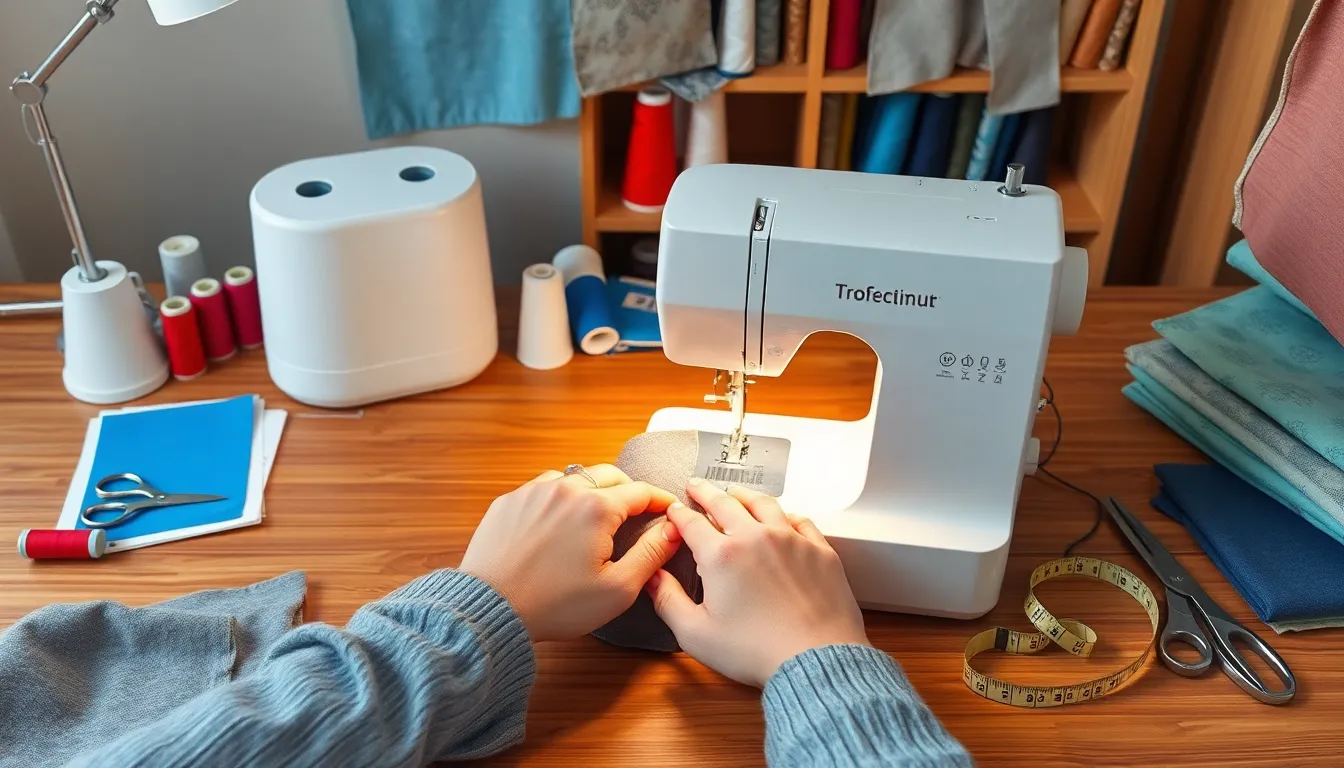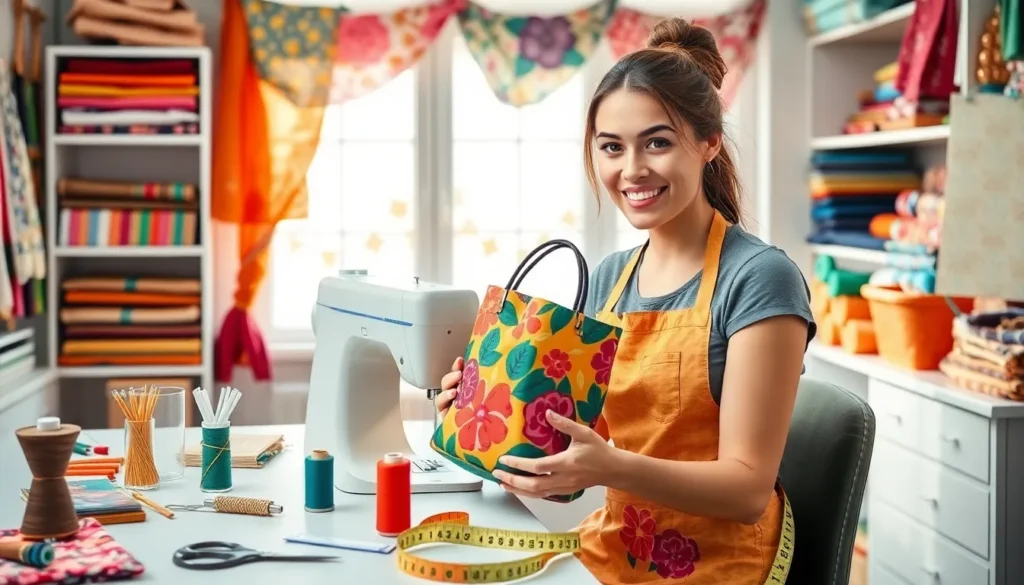Sewing isn’t just for grandmas and fashion designers anymore. It’s a creative outlet that can transform everyday fabric into something extraordinary. Whether you’re looking to whip up a quirky tote bag or a cozy blanket, DIY sewing projects offer a fun way to unleash creativity while saving a few bucks. Plus, who doesn’t want to impress friends with a handmade masterpiece?
Table of Contents
ToggleBenefits of DIY Sewing Projects
DIY sewing projects provide numerous advantages, making them popular among crafters. Individuals gain a sense of accomplishment by creating something tangible with their own hands. Creativity flourishes as each project allows for personal expression through fabric choices and designs.
Cost savings often come into play as well. By making their own items, people avoid retail markups on clothes and accessories. This practice encourages recycling and upcycling, reducing waste in landfills.
Skill development represents another significant benefit. As individuals engage in various projects, they enhance their sewing abilities, learning new techniques and improving their dexterity.
Stress relief frequently arises as an unexpected advantage. Sewing serves as a mindfulness activity, allowing individuals to focus and unwind while concentrating on their creations. Completing a project can boost mood and create a sense of satisfaction.
Social connections emerge through shared sewing experiences. Many join community groups or online forums, where they can exchange ideas, tips, and support on their sewing journeys. These interactions foster friendships grounded in a common interest.
Additionally, flexibility in choosing projects remains appealing. Whether crafting simple pillowcases or more complex dresses, individuals tailor their sewing experiences to skill level and available time. Customization often yields unique, personalized items that reflect their style and preferences.
Ultimately, DIY sewing projects enrich lives by blending creativity, practicality, and community. Engaging in sewing can cultivate a lifestyle centered around sustainability, artistry, and personal growth.
Essential Tools and Materials

DIY sewing projects require specific tools and materials for effective execution. Understanding these essentials ensures a smooth and enjoyable sewing experience.
Sewing Machine Basics
A reliable sewing machine serves as the foundation for most projects. Familiarity with machine settings enhances usability and efficiency. Different machines cater to various sewing needs, from basic models for beginners to advanced ones for experienced sewists. Important features include stitch options, automatic threading, and adjustable speeds. Regular maintenance, such as cleaning and lubrication, prolongs the machine’s lifespan.
Must-Have Sewing Supplies
Essential sewing supplies complement machines and facilitate successful projects. Fabric selection plays a critical role; cotton and linen work well for beginners. Thread choice matters, too; using color-matching polyester or cotton threads creates polished finishes. Scissors are indispensable for cutting fabric precisely. Pins and safety pins hold pieces together during assembly, ensuring accuracy in alignment. A measuring tape helps achieve proper dimensions, while a seam ripper assists in correcting mistakes efficiently.
Beginner-Friendly DIY Sewing Projects
Beginner-friendly DIY sewing projects offer great opportunities to start creating. They enable individuals to build essential skills and express creativity.
Simple Tote Bags
Creating simple tote bags stands out as a popular choice for novice sewists. Tote bags require minimal materials, making them budget-friendly options. Start with sturdy cotton fabric, thread, and handles. Following a straightforward pattern aids in mastering basic sewing techniques. Many online tutorials provide step-by-step guidelines, enhancing the learning experience. Customizing tote bags with fabric paint or patches adds a personal touch. Finished tote bags serve practical purposes, from grocery shopping to carrying books, thus encouraging individuals to showcase their new skills.
Pillow Covers
Pillow covers represent another excellent DIY sewing project for beginners. Selecting fabric that complements existing home decor enhances creativity. Using a simple envelope closure design simplifies assembly while delivering a polished look. Basic sewing techniques like straight stitching and measuring accurately apply here, bolstering confidence. Patterns available online offer various styles, ensuring choices match personal taste. Once completed, pillow covers transform spaces, providing pops of color and comfort. They also allow for experimenting with different fabrics and textures, making each project unique and enjoyable.
Intermediate DIY Sewing Projects
Intermediate DIY sewing projects offer a chance to expand skills while creating stylish items. Two popular categories are skirts and dresses, along with home decor items.
Skirts and Dresses
Creating skirts and dresses enhances sewing abilities and allows for creativity. Simple patterns like A-line skirts or shift dresses provide a base for customization. Individuals can explore different fabrics and experiment with hems, embellishments, or alterations. Patterns are available in multiple sizes, accommodating a variety of body types. Skillful sewing can transform fabrics into personalized clothing, ensuring a perfect fit. Whether it’s a casual skirt or an elegant dress, intermediate projects can challenge sewists and help them refine their techniques.
Home Decor Items
Sewing home decor items serves both functionality and decoration. Individuals can create cushion covers, table runners, or curtains, adding a personal touch to their spaces. Using various fabric styles enhances the room’s aesthetics, from chic to rustic. Many patterns are adaptable, allowing for mixing fabrics and colors. Sewing techniques improve when working on decor projects, such as inserting zippers in pillow covers or adding linings to curtains. Unique home items not only beautify spaces but also reflect the personal style and creativity of the maker.
Advanced DIY Sewing Projects
Advanced DIY sewing projects offer rewarding challenges that enhance skills and creativity. Engaging in more complex undertakings like quilts and tailored garments allows for personal expression and practical results.
Quilts and Blankets
Creating quilts and blankets provides an opportunity to combine various fabrics into unique designs. Traditional patchwork or modern quilt patterns serve as excellent foundations for these projects. Many sewists choose to incorporate personal themes, using fabric remnants or sentimental pieces, resulting in personalized heirlooms. Crafting a quilt involves layering fabrics, batting, and backing, which creates warmth and texture. Quilting techniques like stippling or creating a bound edge enhance the final product’s quality. Completing a quilt not only showcases sewing proficiency but also offers a cozy, functional item for home use.
Tailoring Garments
Tailoring garments transforms ready-to-wear clothing into custom fits that enhance personal style. Individuals gain skills in taking precise measurements, adjusting patterns, and expertly inserting zippers. Popular projects in this category include fitted dresses or tailored jackets, which showcase the talent for craftsmanship. Specific techniques, such as darts or fitting muslins, help ensure a polished finish. Mastering garment tailoring elevates overall sewing capabilities, as it requires attention to detail and a deep understanding of fabric behavior. Cultivating these skills leads to a wardrobe filled with handmade clothing that embodies individual flair.
Tips for Successful DIY Sewing
Sewing projects thrive on preparation and technique. Implementing smart choices leads to positive outcomes.
Fabric Selection
Choosing the right fabric is crucial for success. Different projects require various fabric types, including cotton for beginners and silk for advanced projects. Weight impacts the drape and overall appearance, so consider lighter fabrics for flowy garments and heavier materials for structured items. Additionally, testing fabric durability ensures longevity. Prioritize color and pattern that resonate; visual appeal boosts creativity. Online resources and local fabric stores can help identify options. Experts suggest pairing fabric with the project’s purpose; this connection enhances aesthetic and functionality.
Stitching Techniques
Mastering basic stitching techniques improves overall projects. Starting with straight stitches provides a solid foundation. Once comfortable, explore zigzag stitching, which offers flexibility for stretch fabrics and raw edges. Understanding seam allowances is vital; 1/4 inch or 5/8 inch are common standards. Implementing techniques like backstitching adds security to seams. Experimenting with different stitch lengths allows for creative flair and adaptability. Practicing techniques on scrap fabric reduces anxiety during actual projects. Incorporate finishing techniques, such as serging or pinking shears, to ensure polished edges. Emphasizing these techniques enhances sewing quality.
DIY sewing projects offer a fulfilling blend of creativity and practicality. They empower individuals to express their unique styles while building valuable skills. Whether it’s a simple tote bag or an intricate quilt, each project presents an opportunity for personal growth and satisfaction.
As more people embrace sewing, the community continues to thrive. Sharing ideas and experiences fosters connections among enthusiasts, making the journey even more enjoyable. With the right tools and techniques, anyone can dive into this rewarding craft.
Sewing not only enhances personal spaces but also promotes sustainability through upcycling and mindful creation. So grab some fabric and thread, and let the sewing adventure begin.






